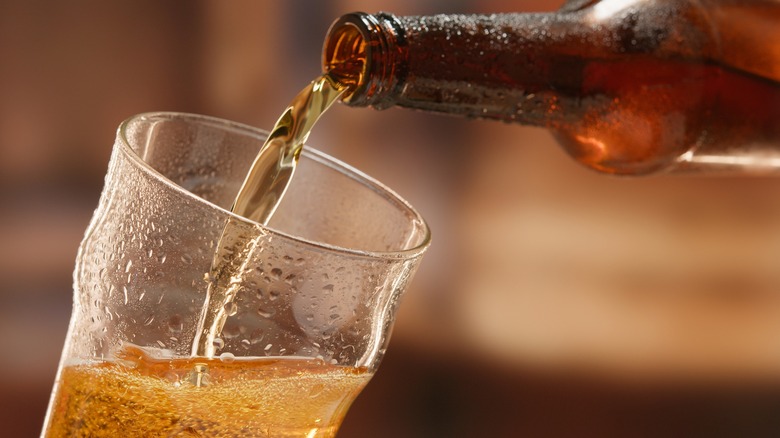What 'Draught' Means On An Imported Beer Label
If you're drinking beers at a bar in America, draft is the term you'll commonly see to describe beer from a keg. Draught, however, is a label that tends to be found on imported beers, as the word is British English with the same meaning. This way of drinking can be traced back to European monks of the Middle Ages who would store extra beer in wooden barrels. This beer would be taken out of the cask by tap instead of using the usual community trough that monks would belly up to with straws. Draught (and draft) are derivatives of the Old English word dragan, meaning to pull or draw, which is exactly what those monks were doing.
In the beer world, the words draft and draught also indicate beers that have not been pasteurized. You may find a pasteurized beer labeled as draft-brewed with a draft taste, but beer taken from a keg is the real deal. Draft beer is served straight from a keg or cask, and the dispensing process typically involves carbonation and pressure control. But if you're asking how the word draught appears on bottles and cans if it is only supposed to label beer pulled from a keg, we got you.
Labeling beer bottles and cans 'draught'
When buying beer in the United States, regulations stipulate what should be printed on labels. As cute as that craft beer label might be, what is written on it communicates important details to thirsty buyers. But draft or draught don't have one set meaning on a label. They're really added as a marketing tool because beer lovers insist that a freshly pulled draft pint tastes better than beer in a bottle or can. So you'll see both imported and American beer labels with draught or draft on them, even when the bottle or can is clearly not a drink poured from a tap or keg. For mass-produced cans or bottles with draft or draught on the label, the reality is that draft-style or draft-flavor might be a more apt description.
Miller Genuine Draft, for instance, uses the moniker to signal that the beer is made in the same way as its beer served from kegs or barrels. So it should be similar in taste to tap beer in a bar, but most experts will tell you that it is not the same, as the storing and pouring processes produce the nuanced results they love. Imported beers like Guinness have draught on the labels as the nitrogen widget in the can or bottle helps each pour mimic what you'd receive from a keg in a pub. Now that your mind is full of beer-related vernacular, it's probably time to pour yourself a pint.

